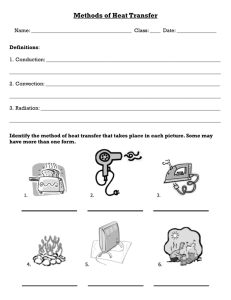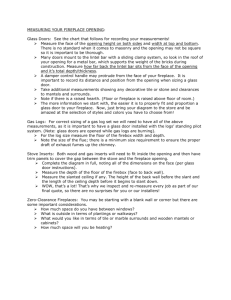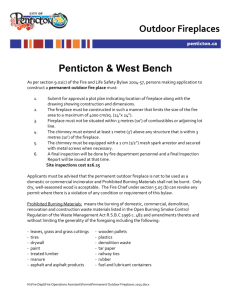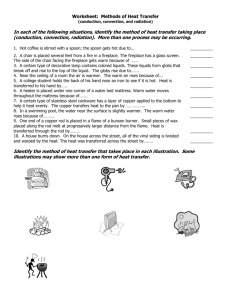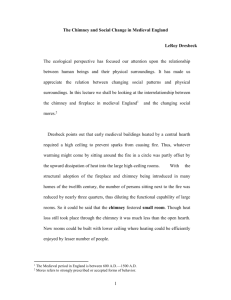jmMLTMxm, Improving Fireplace Efficiency
advertisement
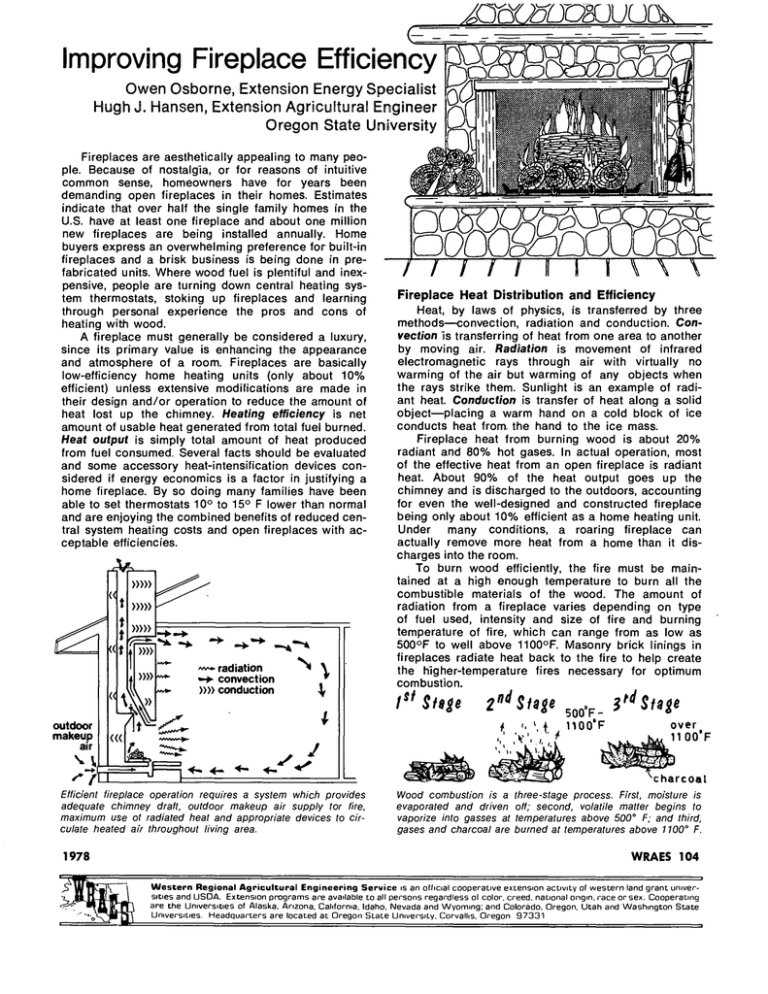
G jmMLTMxm, Improving Fireplace Efficiency Owen Osborne, Extension Energy Specialist Hugh J. Hansen, Extension Agricultural Engineer Oregon State University Fireplaces are aesthetically appealing to many people. Because of nostalgia, or for reasons of intuitive common sense, homeowners have for years been demanding open fireplaces in their homes. Estimates indicate that over half the single family homes in the U.S. have at least one fireplace and about one million new fireplaces are being installed annually. Home buyers express an overwhelming preference for built-in fireplaces and a brisk business is being done in prefabricated units. Where wood fuel is plentiful and inexpensive, people are turning down central heating system thermostats, stoking up fireplaces and learning through personal experience the pros and cons of heating with wood. A fireplace must generally be considered a luxury, since its primary value is enhancing the appearance and atmosphere of a room. Fireplaces are basically low-efficiency home heating units (only about 10% efficient) unless extensive modifications are made in their design and/or operation to reduce the amount of heat lost up the chimney. Heating efficiency is net amount of usable heat generated from total fuel burned. Heat output is simply total amount of heat produced from fuel consumed. Several facts should be evaluated and some accessory heat-intensification devices considered if energy economics is a factor in justifying a home fireplace. By so doing many families have been able to set thermostats 10° to 15° F lower than normal and are enjoying the combined benefits of reduced central system heating costs and open fireplaces with acceptable efficiencies. "*- radiation >> convection »» conduction T rr Fireplace Heat Distribution and Efficiency Heat, by laws of physics, is transferred by three methods—convection, radiation and conduction. Convection is transferring of heat from one area to another by moving air. Radiation is movement of infrared electromagnetic rays through air with virtually no warming of the air but warming of any objects when the rays strike them. Sunlight is an example of radiant heat. Conduction is transfer of heat along a solid object—placing a warm hand on a cold block of ice conducts heat from, the hand to the ice mass. Fireplace heat from burning wood is about 20% radiant and 80% hot gases. In actual operation, most of the effective heat from an open fireplace is radiant heat. About 90% of the heat output goes up the chimney and is discharged to the outdoors, accounting for even the well-designed and constructed fireplace being only about 10% efficient as a home heating unit. Under many conditions, a roaring fireplace can actually remove more heat from a home than it discharges into the room. To burn wood efficiently, the fire must be maintained at a high enough temperature to burn all the combustible materials of the wood. The amount of radiation from a fireplace varies depending on type of fuel used, intensity and size of fire and burning temperature of fire, which can range from as low as 500oF to well above 1100oF. Masonry brick linings in fireplaces radiate heat back to the fire to help create the higher-temperature fires necessary for optimum combustion. /" sttii 500 F- noo'F •. 3t(,$f<ite over UOO'F j <* r Efficient fireplace operation requires a sys(em which provides adequate chimney draft, outdoor makeup air supply lor fire, maximum use ot radiated heat and appropriate devices to circulate heated air throughout living area. 1978 m Wood combustion is a evaporated and driven vaporize into gasses at gases and charcoal are charcoal three-stage process. First, moisture is oft; second, volatile matter begins to temperatures above 500° F; and third, burned at temperatures above 1100° F. WRAES 104 Western Regional Agricultural Engineering Service is an official cooperative extension activity of western land grant universities and USDA. Extension programs are available to all persons regardless of color, creed, national origin, race or sex. Cooperating are the Universities of Alaska. Arizona. California. Idaho. Nevada and Wyoming; and Colorado. Oregon. Utah and Washington State Universities. Headquarters are located at Oregon State University. Corvalhs. Oregon 97331 Chimneys The fireplace chimney must be designed and built so that it produces enough draft to supply adequate air to the fire and to expel smoke and gases emitted by combustion. The flue is the passageway in the chimney through which air, gases and smoke travel. Its crosssectional area, height, shape, tightness and smoothness determine the chimney's effectiveness in producing adequate draft and expelling smoke and gases. Soundness of the flue walls may determine the safety of the building should a chimney fire occur. Overheated or defective flues are one of the chief causes of house fires. Chimneys located on interior walls maintain higher flue temperatures, thus reducing the tendency for creosote to condense on flue walls when smoke temperatures drop below about 250oF. Proper ratios between the area of fireplace front opening, area of fireplace throat or damper, area of flue and height of flue are essential for satisfactory fireplace operation. A lined flue 22 feet high should have a cross-sectional area at least 1/12 of the fireplace opening area. An unlined flue or a flue less than 22 feet high should have a cross-sectional area at least 1/10 that of fireplace opening. Fireclay tile flue liners are definitely recommended for brick chimneys because mortar and bricks directly exposed to flue gases disintegrate with use, causing cracks in the masonry which reduce draft and increase fire hazard. The throat area immediately above the fireplace must be no less than that of the flue—length must be equal to width of fireplace opening. The width is dependent on width of damper frame. Chimneys may contain more than one flue. A separate flue should be used for each fireplace, wood stove and gas or oil furnace or water heater. Connecting more than one combustion unit to a flue may result in carbon monoxide gases or sparks from one unit being drawn into living area by backdrafting through an open draft, fireplace or wood stove. A chimney should extend at least 3 feet above flat roofs and 2 feet above a roof ridge or any other part of roof within 10 feet of chimney. A hood should be provided if a chimney cannot be built high enough above a ridge to prevent trouble from eddies caused by wind being deflected from the roof or nearby trees or terrain. The open ends of the hood should be parallel to the ridge. Metal pipe extensions are sometimes used to increase flue height. Such extensions must have the same cross-sectional area as the flue. Spark-arresting screens securely fastened over top of chimney are recommended to reduce hazards of escaping sparks. Rustresistant screen with openings no larger than 5/8-inch nor smaller than 5/16-inch across should be used. Every chimney should be tested before being used and preferably before it has been furred, plastered or otherwise enclosed. To test a chimney, build a paper, straw, wood or tar-paper fire at the base of the flue. When the smoke rises in a dense column, 3 minimum from roof penetration. Chimney must extend at least 3 teet above any root surface and 2 feet higher than any part of building within 10 feet. tightly block the outlet at the chimney top with a wet blanket. Smoke escaping through masonry indicates the location of leaks. Such defects may be hard to repair but should be corrected before chimney is used. Chimneys should be inspected at least every fall for defects. Check for loose or fallen bricks, cracked or broken flue lining and excessive soot or creosote accumulation. Lower an electric trouble light into flue to make inspection easier. Soot deposits can be dislodged by pulling a weighted sack of straw or a bundled-up tire chain up and down the flue. Seal fireplace opening or flue opening to wood stove when cleaning to keep soot out of living area. Chemical soot removers are not very effective in removing soot and may cause soot to burn, thus creating fire hazards or even explosions under certain conditions. Creosote collected on chimney flues is more difficult to remove; the surest and safest method is to chip it from masonry, being careful not to knock out mortar joints or damage flue lining. Fireplace Damper The greatest heat loss from a conventional open fireplace is through the damper. The damper consists of a cast-iron frame with a hinged lid to open or close the throat opening above the fireplace. It is important that the full clamper opening area be equal to or greater than the flue area in size. Dampers are not always installed in fireplaces but are definitely recommended, especially in cold climates and consistently windy areas. A well-designed, properly-installed damper will: » allow regulation of draft • permit adjustment of throat opening according to type of fire and draft to reduce heat loss up chimney • close off flue to prevent heat loss from living area when fireplace is not being used • close off chimney in summer to prevent insects, birds or bats from entering house through chimney. Close attention should be given to damper positioning in order to minimize loss of heat up the chimney. Generally, it should be opened just enough to prevent fireplace from smoking, and no more. Outside Air inlet Wood requires large quantities of "makeup" air for proper combustion. This means a properly-operating fireplace will draw from 200 to 600 or more cubic feet of air per minute up the chimney. Unless special inlets provide outdoor air to satisfy this makeup requirement, combustion air for a fireplace is drawn from warm air inside the house. Cold outdoor air must infiltrate into the house to replace warm air being used to support the fireplace fire. A normal fire requiring 400 cubic feet of air per minute will draw the equivalent of all the air in a 15- by 20-foot room in about six minutes. Normally, the average house has only about one air change per hour due to infiltration through vents, cracks around doors and windows and other air openings. CAUTION—With today's tightly-constructed houses incorporating weather stripped doors, caulked windows and self-closing exhaust vents, it is possible for a fireplace to set up a reverse draft and suck poisonous carbon monoxide fumes from combustion-type water heaters or furnaces and discharge them into the living area. Also, in tight homes, the furnace may consume Devices to Increase Fireplace Efficiency There are many devices on the market that can be added to any conventional fireplace to increase heat output and efficiency. Most fireplace add-on devices will help produce or reclaim more usable heat than is possible without them. But one must beware of manufacturers' excessive claims. A fireplace will not be able to heat an entire home simply by installing an add-on. Distributing heat throughout the home requires heating ducts and circulating fans to carry heat from the fireplace to other rooms. Also, always bear in mind that an "efficiency increase" of 40 or 50% still makes a fireplace only 14 or 15% efficient as a heating unit. Outside air inlet should channel outdoor air directly to fireplace to reduce amount ol heated air drawn from living area to support combustion. enough oxygen from the air in the house to cause problems to occupants. To be safe, a positive source of outside air should be supplied to all fireplaces and wood- or coal-burning stoves. This can be provided by installing an outside air vent or opening a window when the fireplace is being used. Many local building codes now require installation of outside air inlets to fireplaces, wood stoves and combustion-type water heaters and furnaces. For fireplace installation, a non-combustible duct of 26-gauge or heavier sheet metal should be installed to bring makeup air from crawl space or outdoors directly to the fireplace. The inlet grill(s) may be located in the wall alongside fireplace, in the hearth, or preferably within the firebox on floor or sidewall as far forward as possible and 11/2 inches above fireplace floor so no ashes can spill into it. The duct should be a minimum 3 inches in diameter, and preferably should have a crosssectional area at least 50% that of the chimney flue. The duct should be screened at the opening to keep out insects and rodents and must have a damper at the fireplace outlet to allow closing off when not in use. If fireplace has an ash pit or dump, outside air can often be ducted through it to the firebox floor. Adaptor units are commercially available to transform the existing ash pit opening to a dampered, protected air inlet. Radiant Fireplace Grates are grates designed to hold burning logs in such a manner that more radiant heat is delivered into the living area than is possible with conventional cradle grates. The grate framework arranges logs to form an open cavity of exposed hot coals facing outward to radiate maximum heat into the living area. Extra firewood forms a canopy over the burning logs, with underside of canopy becoming a reflecting wall of hot coals. These grates can be used with or without glass fireplace enclosures. Some grate designs self-feed logs into the fire, thus requiring less tending and stirring of the fire. Radiant grates arrange burning logs such that greatest possible amount ol radiant heat is directed towards living area. Glass Fireplace Enclosures offer a good, simple and economical method of conserving fireplace heat by reducing loss of heated air up the chimney by 60 to 85%. Properly-fitted glass enclosures are attached to fireplace front or face and are partially airtight. Glass doors do substantially reduce amount of heat radiated from the fire into living area. An adjustable damper mechanism at bottom of enclosure provides precise regulation of burning rate but prevents drawing excessive warm air from living area into fireplace and up chimney. Furthermore, since damper mechanism is located at inlet to fire rather than at smoke outlet, both damper and glass doors can be closed when fire is left unattended. The smoldering fire is safely contained, allowing smoke J outside i* air f- inlet M M Ash pit opening may be modified into a very practical outside air inlet. Glass fireplace enclosures ot a good quality and properly used probably offer the greatest heat-conserving device available lor fireplace retrofitting. to escape up chimney but significantly reducing amount of pre-heated air going up with it. The greatest heat savings with glass enclosures occurs as the closed doors reduce heat loss up the chimney when fireplace is not in use. A tight-fitting metal cover over fireplace opening could also be used to reduce this heat loss. Some glass enclosure sets combine a curved tube or flat grill heat circulator (see below) as part of the unit. These units circulate room air through tubes or manifolds to be heated and then blown back into living area—thus giving benefits of convection (air) heat as well as some radiant heat from the fireplace. Fireplace Heat Circulator Units are placed on fireplace floor and have ducted chambers located directly below the fire grate and burning logs. Some units use the ducts as the grate for holding wood. A fan forces cold air through the inlet duct and into the exchanger. The warmed air is then recirculated back into the living area. Most units come with an adaptor panel to accommodate glass enclosures and are most effective when used with glass enclosures. warm air out cold air in heat output of a fireplace by about 50%—giving an overall heating efficiency of maybe 15% as compared to 10% without it. Before installing a curved tube heater, make certain fireplace is deep enough to accommodate unit and allows enough space between the tubes to reach and operate the damper control arm. Blower-Equipped Tube Heaters used with glass enclosures can double heat output of a fireplace—raising heating efficiency from 10% to possibly 20%. An electric fan and motor attachment propels from 100 to 200 cubic feet per minute of heated air beyond fireplace opening and well into room area. Blower-equipped tube heaters come either with fan fastened to lower tubes as a manifold and with a flexible metal hose leading to a remote motor, or with both motor and fan mounted directly on front of heater tubes. Both types require a nearby electrical outlet. Again, measure fireplace opening carefully before purchasing a tube heater/blower unit to make certain it will fit. Grate Blowers capitalize on the fact that he3t of the fire interior is far greater than that of the flames. Grate blowers use that normally untapped coal heat to increase efficiency and heat production of the fireplace. The fire is built directly on top of the unit as with a normal fire grate. Heat from coals is conducted to interior of the device, where incoming air is warmed as it passes through a series of baffles. A blower forces heated air through tubes and into the room area at floor level. The grate-type blower unit does not require a roaring fire to produce additional heat. Even after the fire has burned down to a bed of coals, the device will generate considerable usable heat by pulling heat out of the coals. Heat circulator units circulate room air through heating baffles located directly below burning logs and back into living area. Curved Tube Convection Heater principle is quite simple. When a fire is built over the lower tubes, heated air in the tubes expands, causing an upward flow through the tubes. The rising heated air is forced out of the tubes and new air is sucked into the bottom tubes in a continuous flow. The simplest tube heater design relies solely on the natural flow of heated air to move warmed air into the room. To accomplish this, the non-blower models must be positioned with upper ends of tubes within two inches of top of the fireplace opening. Such placement helps force heated air far enough into room to rise away from fireplace opening and not be sucked back into fireplace with combustion air. The blower-less unit, when used with glass enclosures, can increase warm air warm air out Grate blower assemblies have hollow tubes and a Ian which forces room air through grates and blows warmed air back into living area. WARNING: All heat circulator units using any portion of metal air chamber or baffle as a grate to support burning wood should be inspected after every 30 days of use for burnout holes—any burning material falling into air chamber could be blown into living area, causing a fire hazard. Summary cold air Curved tube heaters draw room air into heating tubes and circulate the warmed air back into living area, either by natural convection or with a fan. Selecting and using appropriate heat reclamation fireplace accessories can materially increase the heating efficiency of a fireplace—conceivably bringing it up to 20-25% efficiency. Accessory devices should be chosen with an eye to efficiency, economy, practicality and aesthetic appeal. This fact sheet based on manuscript originally prepared and approved lor publication by Extension Service, Oregon State University.
